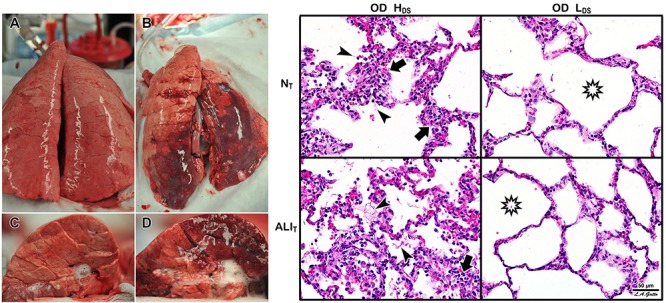FIGURE 5.

Heterogeneous Tween Injury in pigs ventilated for 6 h. A bronchoscope was used to deliver Tween to the dependent areas of the diaphragmatic or caudal lung lobes. Thus, the upper lobes would be normal homogeneously inflated tissue (i.e., would simulate the baby lung), and the dependent areas of the caudal lobe would model acutely injured tissue that would be either collapsed or unstable during tidal ventilation. Using this injury model we can determine whether a ventilation strategy protects either normal tissue (NT) or acutely injured lung tissue (ALIT), protects neither, or protects both. Two groups were studied. Both groups were subjected to a high static strain (Pplat = 40 cm H2O) hypothesized to be sufficient to cause overdistension (OD)-induced VILI to the baby lung (Acute Respiratory Distress Syndrome Network, 2000). One group was also subject to high dynamic strain (HDS) and the other to low dynamic strain (LDS). The dynamic strain was adjusted using the airway pressure release ventilation (APRV) mode by changing the expiratory duration, which changed tidal volume size. Left – Gross photographs of the whole lung (A,B) and cut surface (C,D) of the diaphragmatic lung lobe. The LDS group (A,C) showed minimal damage in both NT and ALIT lung tissue (i.e., no dark red hepatized atelectasis). This was in contrast to the HDS group, in which there was severe injury in both the NT and ALIT lung tissues (B,D). Right – In the OD + HDS group (OD + HDS), widespread histopathology typical of ARDS was seen, with inflammatory cell inflation (arrows) and fibrin deposits (arrowheads) in both the NT and ALIT lung tissue. In the OD + LDS group, minimal histopathology was seen, and alveoli remained open (stars) in both NT and ALIT lung tissue. These data support Protti et al.’s (2013b) work and demonstrate that normal lung tissue is highly resistant to static strain-induced volutrauma. In addition, this study showed that acutely injured lung tissue is also resistant to volutrauma as long as dynamic strain remains low. Both normal and acutely injured lung tissue are highly susceptible to high alveolar R/D-induced VILI when under high inflation pressure (Jain et al., 2017). These data support the rapid progression of lung injury in a power-law fashion when high static and dynamic strain are combined (Hamlington et al., 2018).
